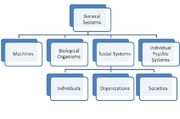
The Relation of General and Social Systems
Systems Theory
Authors: Ludwig von Bertalanffy and Kenneth Berrien
Bess, J., Dee, J. (2012). General and social systems theory. Understanding college and university organizations: Theories for effective policy and practice. (p. 88-125). Sterling, VA: Stylus
Systems theory comprises framework that permits the identification of key inputs, outputs, and transformative processes in organizations, such as colleges and universities, at both the institutional and individual levels. Most conceptualizations of systems theory are positivist in focus and emphasize rational rather than normative language. Systems theory is considered broad and general and allows one to make broad generalizations about the character of an organization or a worker or his or her activities. Broad generalizations allow attention to be drawn to the essential elements in organizations that are stable and to those whose relationships to one another are changing. It is helpful in analyzing and explaining behavior of two complex systems: organizations and individuals (Bess and Dee, 2012, p. 91-93)
Grand Theory
Authors: Talcott Parsons
Bess, J., Dee, J. (2012). General and social systems theory. Understanding college and university organizations: Theories for effective policy and practice. (p. 92). Sterling, VA: Stylus
Grand theory focuses was social systems as a whole and the nature and relationships of their component parts.
General Systems Theory
Authors: Ludwig von Bertalanffy
Bess, J., Dee, J. (2012). General and social systems theory. Understanding college and university organizations: Theories for effective policy and practice. (p. 93-112). Sterling, VA: Stylus
General systems theory was conceptualized at a very high level of abstraction so that it could apply to systems from single cells within organisms to complex human societies.
- System- set of components or elements that are interrelated, interactive, and interdependent (i.e. college or university)
- Boundary- part of a system that separates it from other systems, allows the system to define its identity, provides protection for the system through its filtering or selection mechanism, and acts as a point of contact and exchange with other systems in the environment (i.e. physical location of campus)
- Open system- system that can carry out exchanges with the environment more easily (i.e. community college)
- Closed system- system that restricts exchanges (i.e. private school)
- Boundary Permeability- related to system's vitality and energy consumption; overbounded-too much energy expended; underbounded- too much energy wasted (i.e. duplication of work)
- Interface- space through which exchanges between systems pass (i.e. the space between two pertinent offices)
- Environment- everything beyond the boundary of the system (i.e. state agencies)
- Inputs- energy elements from the environment that are absorbed through the boundary (i.e. human resources, technology)
- Storage and Memory- when resources/inputs are not immediately used, the system must have in place a way to store the inputs (i.e. admissions applications)
- Components or Subsystems- basic units of the system (i.e. department of Financial Aid)
- Structure- pattern of relationships among components that exists at any given time (i.e. interdepartmental relationships)
- Differentiation and Specialization- separating people or organizational units into specialized roles where expertise can be exercised, but then finding ways to connect them organizationally and attitudinally (i.e. cross training of offices)
- Transformations- inputs stored for later use can be transformed (i.e. student taking developmental credit hours are transformed into students taking regular college courses)
- Black Box- interactions in the system that do not fit in general or social systems (i.e. email)
- State of the System- degree of openness of the system, the adaptability and variability of the system, and the stability and equilibrium of the system (i.e. admissions policy that limits student enrollment)
- Equilibrium and homeostasis- stability of system; continuous adjustment of system (i.e. adding new academic programs)
- Equifianality- systems can reach the same end from different initial positions and through different paths (i.e. different policies across state institutions)
- Outputs- exported products of the system (i.e. students who graduate)
- Feedback- means for organizations to determine how outputs compare with goals and how well options are received in the environment (i.e. retention rates)
- Entropy- tendencies of systems to drift toward disorder (i.e. duplication of duties)
Social Systems Theory
Authors: Ludwig von Bertalanffy
Bess, J., Dee, J. (2012). General and social systems theory. Understanding college and university organizations: Theories for effective policy and practice. (p. 109-112). Sterling, VA: Stylus
Social systems theory focuses on the individual and how he fits within the general systems theory. The main system in social systems theory is the individual. There are two tracks to help explain individual behavior:
- Nomothetic-comprises the forces external to the individual such as organization, roles, and expectations
- Idiographic-comprises the forces internal to the individual such as personal beliefs, personality, and need disposition
Organized Anarchy
Author: Cohen, M. and March, J.
Bess, J., Dee, J. (2012). General and social systems theory. Understanding college and university organizations: Theories for effective policy and practice. (p. 118-119). Sterling, VA: Stylus
Cohen, M., March, J. (1974). Leadership and ambiguity: The American college presidency. New York: McGraw-Hill.
Organized anarchy is characterized by problematic goals, unclear technologies and fluid participation. Goals are difficult to state within a college or university because they are hard to define, operationalize, and measure. Technologies may not always be well understood among faculty members. Governance and decision making are dependent on participation.
Chaos Theory
Author: Lorenz, E.
Bess, J., Dee, J. (2012). General and social systems theory. Understanding college and university organizations: Theories for effective policy and practice. (p. 119). Sterling, VA: Stylus
Lorenz, E. (1993). The essence of chaos. Seattle: University of Washington Press.
Chaos theory establishes the challenges of being able to make accurate predictions about the external environments in which systems are embedded. Leaders face difficulty when using historical or present-day data to predict the future state of the environment, as the environment is in constant flux.